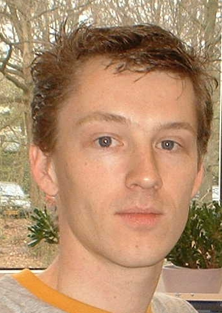Deposition of Metal Islands, Metal Clusters and Metal Containing Single Molecules on Self-Assembled Monolayers
Promotion Date: 01 April 2005
| The aim of the project is to make patterns on surfaces. These patterns vary in size from real nanolevel to micrometres. We use metals to make these patterns applying techniques like pulsed laser deposition and single molecules deposition. For the single molecule work we had a cooperation with the University of Parma, Italy. As a basis for our deposition we used self-assembled monolayers, which are used a lot in our group. Self-assembled monolayers are very thin, only one molecule thick, and they are fairly easy to make and well defined. The metal islands are like flat pancakes on the monolayer made by pulsed laser deposition though a shadow mask, the clusters are deposited at random using short pulsed laser deposition and the single molecules fill the gaps created in our monolayer. The last two methods are fairly unstructured. |
What was your thesis about?
The aim of the project is to make patterns on surfaces. These patterns vary in size from real nanolevel to micrometres. We use metals to make these patterns applying techniques like pulsed laser deposition and single molecules deposition. For the single molecule work we had a cooperation with the University of Parma, Italy. As a basis for our deposition we used self-assembled monolayers, which are used a lot in our group. Self-assembled monolayers are very thin, only one molecule thick, and they are fairly easy to make and well defined.
The metal islands are like flat pancakes on the monolayer made by pulsed laser deposition though a shadow mask, the clusters are deposited at random using short pulsed laser deposition and the single molecules fill the gaps created in our monolayer. The last two methods are fairly unstructured.
Why do you do all this and why these three different techniques?
The idea behind these kinds of projects involved with pattern making is to find an alternative for the standard lithography in clean rooms (small patterns are made on silicon wafers, which is getting increasingly difficult and costly: to make faster and smaller Pentium chips for instance is getting more expensive for every generation).
We want to develop new methods for making small metal features in a controlled way. Another aim of my project was the application of these small structures in molecular electronics. This was more or less a direction of research that I chose myself, which I was free to do since this was a MESA-project and I was not tied up in a clearly defined project with close links to industry. But this line of research is still very fundamental.
What would you say is the completely new part about your research?
In depositioning the metal islands and metal clusters we used a new combination of techniques. Pulsed laser deposition for instance, has never been used for the deposition of metals on monolayers, the idea behind it being the high pressure enabling a careful and precise deposition because the monolayer is very fragile.
Any practical applications in sight?
A part of my thesis focused on the problems with monolayers. They are not very stable as yet and the metal can sink through it as it were. As long as that happens you cannot think of practical applications with monolayers as resistors. In literature you’ll find that this was often not properly investigated. You must be certain that your metals are really on top of the layer so that you are absolutely sure about your measurements.
Does it not imply a criticism towards your fellow researchers?
I think it is common knowledge that people may have been too optimistic in this new line of research. Even in the journals ‘Science’ and ‘Nature’ short articles of editors have been published to that respect.
Are you going to write articles?
A few have already been published and a few have been submitted. During my short post doc period I want to finish at least another paper.
What are you going to do next?
I would like to go to America to do a post doc. My wife and I (Monica Brivio) are both applying, and that of course is the difficulty since we want to go to the same place, getting a position 200 miles apart from the other is of course no option. And, if you want to join a good group we won’t get paid. They get many offers for post docs. This means applying for a grant as well.
Sounds a complicated puzzle.
That is true. It means that you have to be realistic and try for more than one option. And fortunately both Monica and I are adaptable people, if the US does not work out, we’ll go somewhere else.
For the summary of the thesis, click here.
Voor de samenvatting van het proefschrift, click hier.

